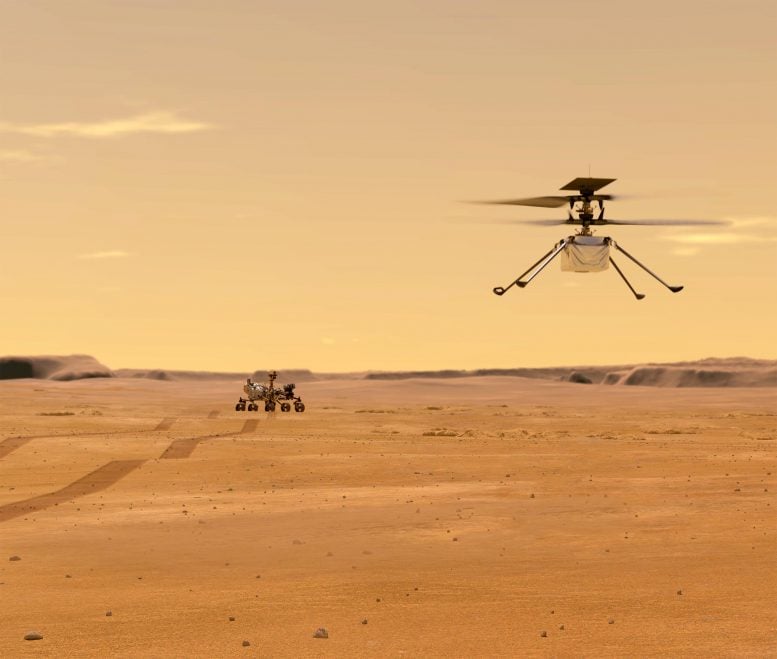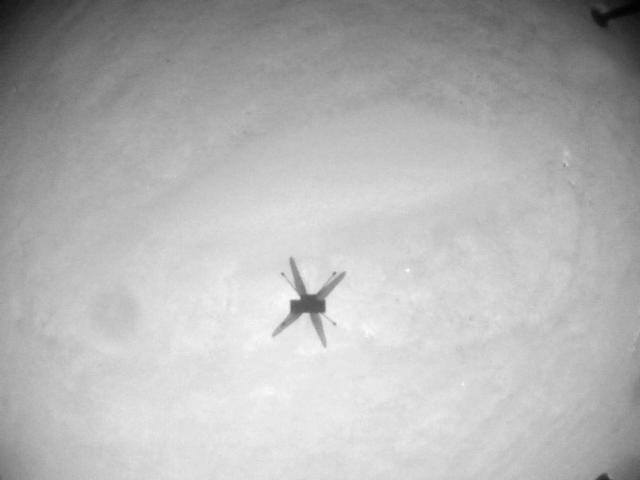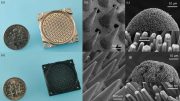
This illustration depicts Mars Helicopter Ingenuity during a test flight on Mars. Ingenuity was taken to the Red Planet strapped to the belly of the Perseverance rover (seen in the background). Ingenuity, a technology experiment, was the first aircraft to attempt controlled flight on another planet in 2021. Credit: NASA/JPL-Caltech
In the months since we flew for the first time, we have learned a great deal about operating a helicopter on Mars. We have explored Ingenuity’s strengths and limitations in detail, leveraging the former and working around the latter to operationalize it as a highly capable reconnaissance platform.
With the benefit of the knowledge acquired, conducting flights on Mars has in most ways become easier than it was at the outset. But in one important way it is actually getting more difficult every day: I’m talking about the atmospheric density, which was already extremely low and is now dropping further due to seasonal variations on Mars.
When we designed and tested Ingenuity on Earth, we expected Ingenuity’s five-flight mission to be completed within the first few months after Perseverance’s landing in February 2021. We therefore prepared for flights at atmospheric densities between 0.0145 and 0.0185 kg/m3, which is equivalent to 1.2-1.5% of Earth’s atmospheric density at sea level. With Ingenuity in its sixth month of operation, however, we have entered a season where the densities in Jezero Crater are dropping to even lower levels. In the coming months we may see densities as low as 0.012 kg/m3 (1.0% of Earth’s density) during the afternoon hours that are preferable for flight.

Mars Helicopter Sol 193 – Navigation Camera: NASA’s Ingenuity Mars Helicopter acquired this image using its navigation camera during its 13th flight on September 5, 2021 (Sol 193 of the Perseverance rover mission) at the local mean solar time of 12:06:30. Credit: NASA/JPL-Caltech
The difference may seem small, but it has a significant impact on Ingenuity’s ability to fly. At our lower design limit for atmospheric density (0.0145 kg/m3), we know that Ingenuity has a thrust margin of at least 30%. Thrust margin refers to the excess thrust that Ingenuity can produce above and beyond what is required to hover. That additional thrust is needed on takeoffs and climbs, during maneuvers, and also when tracking terrain with varying height. But if the atmospheric density were to drop to 0.012 kg/m3 in the coming months, our helicopter’s thrust margin could drop to as low as 8%, which means that Ingenuity would be operating close to aerodynamic stall (a condition where further increases in the blade’s angle of attack does not produce more lift, only more drag).
Thankfully, there is a way to tackle this issue – but it involves spinning the rotors even faster than we have been doing up to now. In fact, they will have to spin faster than we have ever attempted with Ingenuity or any of our test helicopters on Earth. This is not something we take lightly, which is why our next operations on Mars will be focused on carefully testing out higher rotor speeds in preparation for future flights.
We will begin by performing a high-speed spin of the rotor without leaving the ground, reaching a peak rotor speed of 2,800 rpm (more than a 10% increase relative to our prior Mars experience of 2,537 rpm). If all goes well, we will follow this with a short test flight at a slightly lower rotor speed of 2,700 rpm. This would be our 14th flight and (hopefully) a relatively boring one compared to any of our more recent flights, where we flew long distances to acquire images of interest for the Perseverance rover team. Occurring no earlier than Friday, September 17 (with data coming down no earlier than Saturday morning), the short hop would have Ingenuity take off, climb to 16 feet (5 meters), perform a small translation (sideways move), and then land again. And while the results from a Flight 14 should be less than riveting, the significant increase in available rpms (from 2,537 to 2,700) for future helicopter operations will provide us the option to perform scouting missions for Perseverance at lower atmospheric densities. It also leaves some wiggle room if we decide an additional rpm increase is needed later.
A speed increase like this comes with a number of potential issues. One of these has to do with aerodynamics: A rotor speed of 2,800 rpm, in combination with wind and helicopter motion, could cause the tips of the rotor blades to encounter the air at nearly 0.8 Mach – that is, 80% of the speed of sound on Mars. (The speed of sound on Mars is somewhat lower than we are used to – about ¾ the speed of sound on Earth.) If the blade tips get sufficiently close to the speed of sound, they will experience a very large increase in aerodynamic drag that would be prohibitive for flight. For Ingenuity’s rotor we do not expect to encounter this phenomenon until even higher Mach numbers, but this has never been confirmed in testing on Earth.
Another potential issue is unknown resonances in the helicopter structure. Like all mechanical systems, Ingenuity has resonances that can lead to large vibrations when excited at particular frequencies. It is important to ensure that there are no significant resonances at the rotor speed used for flight, as this could cause damage to hardware and lead to a deterioration in sensor readings needed by the flight control system.
Additional demands will also be put on several components of Ingenuity’s design: The motors will need to spin faster, the electrical system will need to deliver more power, and the entire rotor system will need to withstand the higher loads that come with increased rotor speeds. It all adds up to a significant challenge, but by approaching the issue slowly and methodically, we hope to fully check out the system at higher rotor speeds and enable Ingenuity to keep flying in the months ahead. Stay tuned for updates.
Written by Håvard Grip, Ingenuity Mars Helicopter Chief Pilot at NASA’s Jet Propulsion Laboratory.









Be the first to comment on "NASA Ingenuity Helicopter: Flying on Mars Is Getting Harder and Harder"